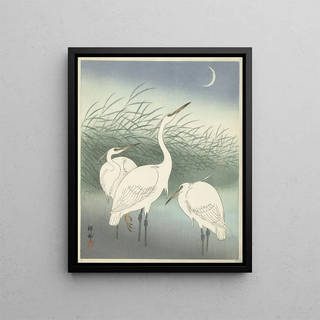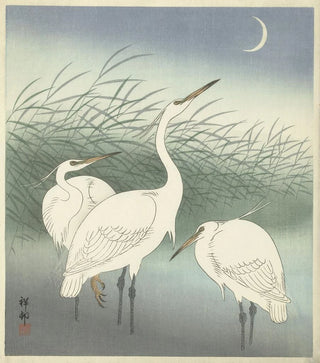Art print | Herons in Shallow Water - Ohara Koson


View from behind

Frame (optional)
Art print Herons in shallow water - Ohara Koson – Captivating introduction
In the fascinating world of Japanese art, the work "Herons in shallow water" by Ohara Koson stands out for its delicacy and serene atmosphere. This piece, emblematic of ukiyo-e aesthetics, invites the viewer to immerse themselves in a world where nature and art harmoniously meet. The herons, majestic and graceful, seem to capture the suspended moment of silent contemplation. Through this work, Koson offers us a window into an aquatic landscape, where every detail is carefully orchestrated to evoke the ephemeral beauty of life.
Style and uniqueness of the work
Ohara Koson's style is characterized by fine execution and meticulous attention to detail. In "Herons in shallow water," soft colors and subtle nuances create a calming atmosphere, while the balanced composition highlights the elegant posture of the birds. The herons, depicted with remarkable precision, almost seem alive, as if they are about to take flight. Koson manages to capture the very essence of these creatures, their natural grace, and their intimate connection with water. The use of space is also significant, with each element placed to reinforce the feeling of tranquility and harmony. This work is not just a simple representation; it becomes an invitation to meditation and contemplation.
The artist and his influence
Ohara Koson, born in 1877, is one of the masters of ukiyo-e, an artistic genre that flourished in Japan during the Edo period. His work, though deeply rooted in tradition, demonstrates a modern sensibility unique to him. Koson was able to draw inspiration from Western influences while preserving the essence of Japanese art. His works, often focused on nature and wildlife, reflect a deep respect for the environment and an admiration for natural beauty. Through his prints, he not only captured scenes of daily life but also contributed to the rediscovery of Japanese art abroad, influencing many contemporary artists. His legacy endures, and

Matte finish

View from behind

Frame (optional)
Art print Herons in shallow water - Ohara Koson – Captivating introduction
In the fascinating world of Japanese art, the work "Herons in shallow water" by Ohara Koson stands out for its delicacy and serene atmosphere. This piece, emblematic of ukiyo-e aesthetics, invites the viewer to immerse themselves in a world where nature and art harmoniously meet. The herons, majestic and graceful, seem to capture the suspended moment of silent contemplation. Through this work, Koson offers us a window into an aquatic landscape, where every detail is carefully orchestrated to evoke the ephemeral beauty of life.
Style and uniqueness of the work
Ohara Koson's style is characterized by fine execution and meticulous attention to detail. In "Herons in shallow water," soft colors and subtle nuances create a calming atmosphere, while the balanced composition highlights the elegant posture of the birds. The herons, depicted with remarkable precision, almost seem alive, as if they are about to take flight. Koson manages to capture the very essence of these creatures, their natural grace, and their intimate connection with water. The use of space is also significant, with each element placed to reinforce the feeling of tranquility and harmony. This work is not just a simple representation; it becomes an invitation to meditation and contemplation.
The artist and his influence
Ohara Koson, born in 1877, is one of the masters of ukiyo-e, an artistic genre that flourished in Japan during the Edo period. His work, though deeply rooted in tradition, demonstrates a modern sensibility unique to him. Koson was able to draw inspiration from Western influences while preserving the essence of Japanese art. His works, often focused on nature and wildlife, reflect a deep respect for the environment and an admiration for natural beauty. Through his prints, he not only captured scenes of daily life but also contributed to the rediscovery of Japanese art abroad, influencing many contemporary artists. His legacy endures, and






